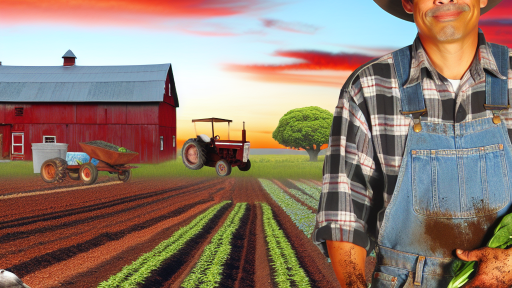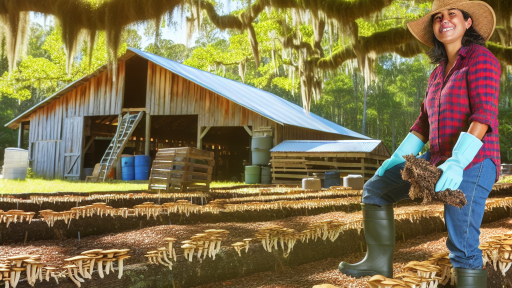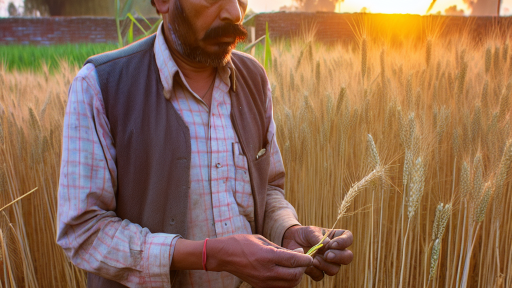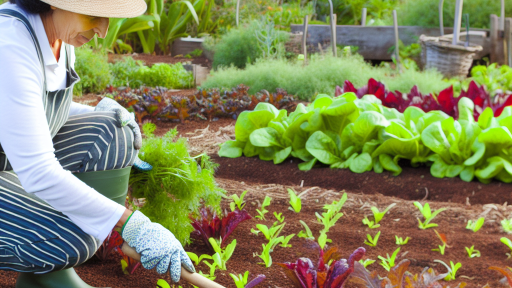Introduction to Edible Landscaping
Definition of Edible Landscaping
Edible landscaping combines aesthetics with food production.
It incorporates a variety of edible plants into garden designs.
This approach transforms traditional landscapes into productive spaces.
Benefits of Edible Landscaping
Edible landscaping offers numerous benefits for small farms.
First, it enhances food security by providing homegrown produce.
This method also reduces dependency on store-bought, processed foods.
Environmental Advantages
Moreover, edible landscaping promotes biodiversity in local ecosystems.
It attracts beneficial insects and wildlife to your garden.
Additionally, these landscapes improve soil health and water retention.
Aesthetic Appeal
Edible landscapes beautify outdoor spaces while serving a practical purpose.
You can select a range of plants that flower, fruit, or have attractive foliage.
This creates visually stunning environments that also yield food.
Cultural and Educational Value
Implementing edible landscaping encourages community engagement.
It provides educational opportunities about sustainable practices.
Hands-on experiences with edible plants foster a greater appreciation of nature.
Transform Your Agribusiness
Unlock your farm's potential with expert advice tailored to your needs. Get actionable steps that drive real results.
Get StartedDesign Principles for Small Farms
Emphasizing Space Optimization
Optimizing space is crucial for small farms.
Every square foot counts in limited areas.
Efficient layouts enhance productivity significantly.
Consider vertical gardening techniques for maximizing space.
Utilizing wall or trellis systems can save ground area.
Choosing the Right Plant Combinations
Companion planting promotes healthier plants.
Mixing different species can deter pests naturally.
Plan your layout to ensure proper spacing between plants.
Layered planting creates microclimates for diverse species.
Creating Functional Zones
Divide your farm into distinct zones.
Designate areas for vegetables, herbs, and pollinator plants.
Ensure easy access to each zone for maintenance tasks.
Organizing spaces reduces time spent on chores.
Incorporating Pathways and Accessibility
Effective pathways improve accessibility across the farm.
Consider materials that are durable yet easy to maintain.
Paths should connect all functional areas seamlessly.
Design routes that accommodate maintenance equipment.
Utilizing Natural Resources Wisely
Incorporate rainwater harvesting systems into your design.
Use local soil and native plants to minimize costs.
Plant saplings strategically for shade and windbreaks.
Understanding your environment helps improve yields.
Selecting the Right Edibles
Fruits for Small Spaces
Fruits can take up minimal space while providing significant rewards.
Consider growing dwarf fruit trees, which can yield abundantly in small areas.
Strawberries are also an excellent choice for limited spaces, thriving in containers or hanging baskets.
Showcase Your Farming Business
Publish your professional farming services profile on our blog for a one-time fee of $200 and reach a dedicated audience of farmers and agribusiness owners.
Publish Your ProfileRaspberries and blueberries adapt well to smaller gardens, producing delicious fruit each season.
Additionally, grow indeterminate tomatoes, which can be trained upward to save space.
Vegetables That Maximize Yield
Many vegetables are ideal for small farms, especially those that grow vertically.
Vining plants like cucumbers and squash can be trellised, allowing for efficient use of ground space.
Leafy greens like spinach and kale grow quickly, offering multiple harvests in one season.
Root vegetables such as radishes and carrots are also efficient, using little surface area.
Include pole beans, which provide nitrogen to the soil while climbing, keeping the ground clear.
Herbs for Flavor and Utility
Herbs are perfect for small gardens because they require little space yet add great flavor.
Basil, parsley, and cilantro can grow well in containers or window boxes.
Herbs like chives and mint can be planted in the ground or in pots, enhancing garden aesthetics.
Additionally, rosemary and thyme thrive in sunny spots while requiring minimal maintenance.
These plants not only flavor dishes but also attract beneficial insects to your garden.
Combining Edibles for Aesthetic Appeal
Create beautiful arrangements by mixing flowers with edibles for visual interest.
Edible flowers, such as nasturtiums, add color and can be used in salads.
Pair vibrant marigolds with vegetables to deter pests while enhancing garden beauty.
Consider planting chard or kale for their stunning foliage alongside herbs.
This combination promotes biodiversity and supports a healthy ecosystem.
Find Out More: Organic Techniques for Hydroponic Gardens
Layering Strategies: Vertical and Horizontal Planting for Maximum Yield
Understanding Layering Strategies
Layering strategies maximize space on small farms.
This approach includes vertical and horizontal plantings.
Both methods enhance the diversity and yield of crops.
Vertical Planting Techniques
Vertical planting utilizes structures for growth support.
Common supports include trellises, cages, and stakes.
Crops like tomatoes, cucumbers, and beans thrive vertically.
This method saves ground space for lower-growing plants.
Also, it increases air circulation and sunlight exposure.
Selecting Suitable Plants
Choose climbing varieties for effective vertical growth.
Consider plants like pole beans and peas.
Artful combinations enhance aesthetics and productivity.
Utilizing Vertical Gardens
Vertical gardens are ideal for limited space.
They can incorporate edible flowers, herbs, and greens.
This innovation creates a lush and productive environment.
Horizontal Planting Techniques
Horizontal planting efficiently uses available ground space.
Plant rows closely to maximize area usage.
Utilize intercropping to enhance crop diversity.
Companion planting also boosts soil health and pest control.
Implementing Companion Planting
Companion plants support each other’s growth.
For instance, basil planted with tomatoes improves flavor.
Marigolds deter harmful pests, benefiting nearby crops.
Rotating Crops
Crop rotation maintains soil fertility and prevents disease.
Showcase Your Farming Business
Publish your professional farming services profile on our blog for a one-time fee of $200 and reach a dedicated audience of farmers and agribusiness owners.
Publish Your ProfileRotate crops to different sections of the garden each year.
This practice rejuvenates soil nutrients effectively.
Maximizing Yield with Mixed Methods
Combining vertical and horizontal planting increases yield.
Create a layered effect in your garden design.
This method utilizes every available inch of space.
Designing an Edible Landscape
Design an edible landscape that flows harmoniously.
Include plants of varying heights and growth patterns.
Layering creates visual interest and biodiversity.
Maintaining Your Garden
Proper maintenance is crucial for an edible landscape.
Regular watering, weeding, and pruning support growth.
Monitor for pests and diseases to maintain health.
Gain More Insights: Composting Techniques For City Farms
Integrating Pollinators and Beneficial Insects into the Landscape Design
Importance of Pollinators
Pollinators play a critical role in agriculture.
They enhance crop yields by facilitating the fertilization process.
Furthermore, they contribute to biodiversity in the ecosystem.
Gardens with diverse plant life attract more pollinators.
Choosing the Right Plants
Selecting a variety of flowering plants is essential.
Consider native plants, as they provide familiar food sources.
Include plants with different bloom times for year-round support.
Examples of beneficial plants include bee balm and sunflowers.
Creating a Pollinator Habitat
Designate areas within the farm for pollinator habitats.
Use clusters of flowers to create abundant resources.
Incorporate water sources, such as shallow dishes or ponds.
Avoid excessive pesticide use to protect these vital insects.
Beneficial Insects in the Garden
Integrating beneficial insects helps manage pests naturally.
Ladybugs and lacewings are excellent examples of natural predators.
Encouraging the right insects can minimize crop damage.
Attracting Beneficial Insects
Planting herbs like mint and dill attracts many beneficial insects.
Provide diverse habitats, such as dense foliage and ground cover.
Consider leaving some areas untouched to promote insect nests.
Maintaining the Ecosystem Balance
Balancing various species strengthens the farm ecosystem.
It also improves the resilience of crops against diseases.
Monitor the insect populations to understand their impact.
Educational Resources
Farmers should stay informed about integrated pest management.
Workshops and local extension services can provide support.
Utilizing community resources can enhance farming practices.
You Might Also Like: Benefits of Heirloom Seeds for Sustainable Farming

Seasonal Planting Guides
Understanding Crop Timing
Timing your crops ensures bountiful yields throughout the year.
By understanding local climatic conditions, you enhance productivity.
Each season brings unique opportunities for growth.
Showcase Your Farming Business
Publish your professional farming services profile on our blog for a one-time fee of $200 and reach a dedicated audience of farmers and agribusiness owners.
Publish Your ProfilePlanning ahead allows for efficient use of resources.
Spring Planting Strategies
Spring is ideal for planting cool-season crops.
Consider starting with spinach, kale, and peas.
These plants thrive in cooler temperatures and can be harvested early.
Simultaneously, sow seeds for warm-season crops indoors.
Tomatoes and peppers benefit from an early start.
Summer Planting Techniques
As temperatures rise, focus on warm-season vegetables.
Popular choices include zucchini, corn, and beans.
In addition, consider intercropping for enhanced yields.
For instance, plant radishes between rows of carrots.
This method optimizes space and decreases pest issues.
Fall Planting Guidelines
In fall, switch back to cool-season crops.
Vegetables such as lettuce, broccoli, and cabbage thrive now.
This is also a great time for cover crops.
Cover crops protect the soil during winter and improve fertility.
Mix clover or vetch to enrich soil health.
Winter Preparations
Use winter for soil amendments and planning.
Evaluate the previous year’s successes and failures.
Incorporate compost and other organic materials.
This will improve soil structure and fertility.
Additionally, plan your crop rotations for the upcoming season.
Uncover the Details: Preserving Heritage Varieties on Your Farm
Irrigation Solutions
Understanding the Importance of Efficient Watering
Efficient watering is crucial for small farms.
It helps conserve water and supports healthy plant growth.
Additionally, it reduces labor costs and boosts productivity.
Types of Irrigation Systems
Several irrigation systems suit small farm layouts.
Each type has unique benefits for water management.
- Drip irrigation delivers water directly to plant roots.
- Sprinkler systems provide even coverage over large areas.
- Subsurface irrigation ensures moisture remains in the root zone.
Choosing the Right System
Selecting the right irrigation system requires assessing your needs.
Consider factors such as crop type and soil characteristics.
Moreover, evaluate budget constraints and available resources.
Implementing Water Conservation Techniques
Incorporating water conservation techniques can enhance efficiency.
For instance, rainwater harvesting can provide a reliable water supply.
Furthermore, mulching helps retain soil moisture and reduce evaporation.
Maintaining Your Irrigation System
Regular maintenance keeps your irrigation system functioning optimally.
Inspect for leaks and clogs to prevent water waste.
Moreover, schedule seasonal checks to ensure proper operation.
Case Studies: Successful Edible Landscaping Projects on Small Farms
Introduction to Edible Landscaping
Edible landscaping combines aesthetics with food production.
This method enhances small farms’ productivity and beauty.
Many farmers have successfully implemented this practice.
Below, we will explore several case studies showcasing these successes.
Showcase Your Farming Business
Publish your professional farming services profile on our blog for a one-time fee of $200 and reach a dedicated audience of farmers and agribusiness owners.
Publish Your ProfileCase Study: Serenity Farm
Serenity Farm transformed its traditional landscaping into an edible oasis.
They planted a diverse range of fruits, vegetables, and herbs.
This variety not only produced food but attracted beneficial insects.
Consequently, their yield increased significantly each season.
Design Features
The farm utilized permaculture principles in their layout.
They created tiered planting beds to optimize space and sunlight.
This innovative approach minimized water usage.
Additionally, they incorporated vertical gardening techniques.
Community Engagement
Serenity Farm hosted workshops to educate the community.
These events encouraged local residents to begin their gardens.
As a result, the local community became more connected to their food.
Case Study: Green Thumb Acres
Green Thumb Acres adopted a unique approach to urban farming.
They transformed their front yard into a vibrant edible garden.
This decision boosted neighborhood interest in sustainable practices.
Moreover, it provided fresh produce to local families.
Plant Selection
The farm focused on planting native species and companion plants.
This strategy improved biodiversity while reducing pests naturally.
The farmers selected crops based on seasonal availability.
This ensured a continuous harvest throughout the year.
Marketing and Sales
Green Thumb Acres also established a community-supported agriculture (CSA) program.
This initiative allowed members to receive fresh produce weekly.
Through this program, the farm generated steady revenue.
Additionally, they built strong relationships with their customers.
Case Study: Blossoming Gardens
Blossoming Gardens utilized their small space efficiently to grow food.
They created edible landscape borders around their property.
This technique maximized productivity even in limited space.
Furthermore, it added visual appeal to the farm.
Plant Integration
The farm integrated ornamental plants with edible options.
Examples include fruit trees with flowering shrubs.
This combination attracted pollinators while producing food.
The diverse ecosystem thrived as a result.
Education and Outreach
Blossoming Gardens partnered with local schools for educational programs.
They organized field trips to teach students about gardening.
These efforts inspired the next generation of farmers.
This initiative significantly impacted local engagement.
Additional Resources
Designing Agricultural Landscapes for Human Well-Being – Edible …
What Everybody Should Know About Profitable Permaculture Farms …




